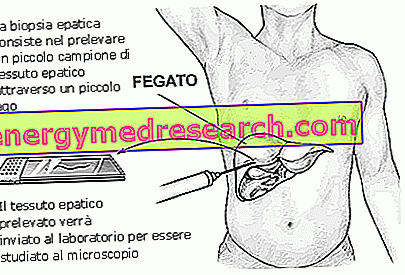Generality
Liver biopsy is a medical procedure based on the removal of a piece of liver tissue by means of a dedicated needle, with the ultimate aim of studying it under a microscope to identify and characterize various liver diseases. The liver biopsy can therefore be used as a diagnostic tool before the suspicion of a liver disease that cannot be investigated with other techniques, or as a tool to establish its severity if it has already been ascertained in other ways. The information provided by a positive liver biopsy also allows to formulate a prognosis and to analyze the most suitable therapeutic intervention possibilities.
Main indications
Since it is an invasive, and therefore potentially dangerous, examination, liver biopsy should only be performed when the patient can derive tangible clinical benefits, or if it is not possible to obtain adequate diagnostic information with less invasive or non-invasive methods.
The main indications for liver biopsy include the diagnosis, staging and grading (stage and grade) of alcoholic liver disease, non-alcoholic steatohepatitis (complications of the so-called fatty liver), autoimmune hepatitis and chronic viral hepatitis type B and C.

How to do it
Based on clinical needs, liver biopsy can be performed using different techniques:
- withdrawal during surgery;
- biopsy during laparoscopic investigation;
- biopsy by transjugular route;
- percutaneous biopsy (overcast);
- ultrasound-guided percutaneous biopsy on focal lesion.
Among these, the most widespread is undoubtedly percutaneous liver biopsy (guided or not). During the exam, the patient is lying on his back or more commonly on his left side, with his right arm placed behind his head. The adoption of this particular position, however comfortable, has the purpose of increasing the space between the ribs. With the ultrasound aid, the doctor identifies the liver and the most suitable body region for the puncture, disinfects it and injects it with a local anesthetic. At this point, a larger biopsy needle (about 1.2 mm in diameter) is introduced and withdrawn quickly into the patient's liver, collecting a frustule of liver tissue. The operation does not last more than a couple of seconds and requires the active collaboration of the patient. This, in fact, before the introduction of the needle, is invited to exhale deeply (letting out all the air from the lungs) and to hold the breath (apnea) for a few seconds, enough to insert and withdraw the needle from a biopsy. This is particularly useful, since the lungs without air are smaller and the liver is in a higher position inside the abdomen.
In the rare event that sufficient quantities of tissue have not been taken, the maneuver will have to be repeated a second time.
In addition to the local anesthetic, a mild sedative (benzodiazepine) and / or intramuscular atropine may be administered at the discretion of the physician; this allows to favor the state of relaxation without impeding the important active collaboration of the patient, preventing at the same time any alterations of pressure and heart rate.
The procedure described above is also referred to as an eco-assistance, given that the correct puncture site is established by means of an ultrasound examination. A variant, called percutaneous ultrasound-guided biopsy on a focal lesion, provides constant echographic monitoring instead. The purpose of this procedure is in fact to take cellular samples of liver tissue from a very specific region of the liver (focal lesion), for example in the area where an abnormal formation has been found.
As anticipated, liver biopsy can also be performed during a major surgical procedure (under general anesthesia) or minimally invasive through laparoscopy, that is, through the insertion - through one or more small incisions of the skin and muscle bands - of small instruments, including a micro camera to perform the sampling in direct view. Laparoscopic liver biopsy can be performed when there is a danger of spreading infections or cancer cells.
Transsugular biopsy is a complex method used in patients who are forced to have chronic anticoagulant therapies, with haemorrhagic diseases or those with ascites. The method involves inserting a canula into a vein in the neck, then descending to the hepatic veins for sample collection.
In the following paragraphs we will analyze the risks, complications and operative modalities of percutaneous liver biopsy alone, which we recall being the most commonly used technique.
Liver biopsy: risks and preparation "



